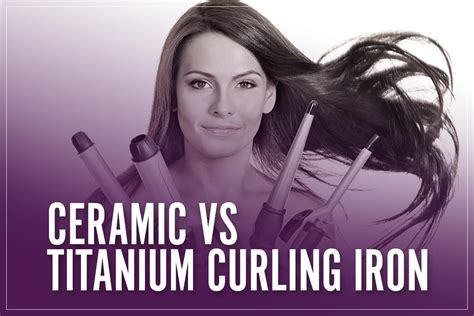If you’re looking for the best curling iron, you’ll need to consider the material of the barrel. The material of the barrel will affect the heat distribution, which in turn will affect the curls you create.

Ceramic
Ceramic is a popular material for curling irons because it heats evenly and produces smooth, shiny curls. Ceramic barrels are also less likely to damage hair than metal barrels.
Benefits of ceramic curling irons:
- Heats evenly
- Produces smooth, shiny curls
- Less likely to damage hair
Drawbacks of ceramic curling irons:
- Can be more expensive than other materials
- Can take longer to heat up
Metal
Metal is another popular material for curling irons. Metal barrels heat up quickly and evenly, and they can create a variety of curl types. However, metal barrels can also damage hair if they are not used properly.
Benefits of metal curling irons:
- Heats up quickly
- Evenly distributes heat
- Can create a variety of curl types
Drawbacks of metal curling irons:
- Can damage hair if not used properly
- Can be more expensive than other materials
Titanium
Titanium is a lightweight and durable material that heats up quickly and evenly. Titanium barrels are also less likely to damage hair than metal barrels.
Benefits of titanium curling irons:
- Heats up quickly
- Evenly distributes heat
- Less likely to damage hair
- Lightweight and durable
Drawbacks of titanium curling irons:
- Can be more expensive than other materials
Tourmaline
Tourmaline is a semi-precious gemstone that emits negative ions when heated. These negative ions help to seal the hair cuticle, which results in smooth, shiny curls. Tourmaline barrels are also less likely to damage hair than metal barrels.
Benefits of tourmaline curling irons:
- Emits negative ions
- Seals the hair cuticle
- Produces smooth, shiny curls
- Less likely to damage hair
Drawbacks of tourmaline curling irons:
- Can be more expensive than other materials
Which material is right for you?
The best material for a curling iron depends on your individual hair type and styling needs. If you have fine or damaged hair, a ceramic or tourmaline curling iron is a good choice. If you have thick or coarse hair, a metal or titanium curling iron is a good choice.
Table 1: Comparison of Curling Iron Materials
| Material | Heat Distribution | Curl Type | Damage to Hair | Price |
|---|---|---|---|---|
| Ceramic | Even | Smooth, shiny | Less likely | More expensive |
| Metal | Even | Variety of curl types | More likely | More expensive |
| Titanium | Even | Less likely | Lightweight and durable | More expensive |
| Tourmaline | Emits negative ions | Smooth, shiny | Less likely | More expensive |
Table 2: Curling Iron Materials and Hair Types
| Hair Type | Best Curling Iron Material |
|---|---|
| Fine or damaged hair | Ceramic or tourmaline |
| Thick or coarse hair | Metal or titanium |
Table 3: Tips for Choosing a Curling Iron
- Consider your hair type.
- Consider your styling needs.
- Read reviews of different curling irons.
- Compare prices.
Table 4: Tricks for Using a Curling Iron
- Use a heat protectant spray before curling your hair.
- Divide your hair into sections before curling.
- Wrap your hair around the barrel of the curling iron and hold for 10-15 seconds.
- Release the curl and let it cool before moving on to the next section.
Conclusion
The best material for a curling iron depends on your individual hair type and styling needs. By following the tips in this article, you can choose the right curling iron for you and create beautiful, healthy curls.
